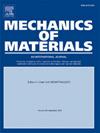On the role of the matrix in the strength of carbon fiber-reinforced ceramics
IF 3.4
3区 材料科学
Q2 MATERIALS SCIENCE, MULTIDISCIPLINARY
引用次数: 0
Abstract
Fiber-reinforced ceramic matrix composites (CMCs) are known for being able to preserve their mechanical properties at much higher temperatures than metal alloys. CMCs low mass density and superior mechanical strength, compared to plain monolithic ceramics, make them candidate materials for high-temperature applications when a significant load-bearing capacity is also required. In this paper, we use a phase field damage model combined with a multiscale approach to explore the mechanical strength of a unidirectional C-SiC composite under a range of uniaxial and biaxial stress conditions. In contrast to existing approaches that propose analytical solutions, restricted to specific load cases and given initial damage configurations, our approach is quite general and does not make any assumption on the type of damage. Starting from a damage free material, the resulting model is capable of reproducing the different failure mechanisms observed in the literature such as bridging of isolated matrix crack, delamination and fiber fragmentation. With this methodology, we can predict the strength and failure mechanics of composites under complex boundary conditions expressed in terms of the components of a macroscopic deformation field acting on the material. Interestingly, we find that under a wide range of cases we investigated, the composite damage consistently initiates in the matrix, far away from the interface with the fibers.
基体对碳纤维增强陶瓷强度的影响
纤维增强陶瓷基复合材料(cmc)以能够在比金属合金更高的温度下保持其机械性能而闻名。与普通单片陶瓷相比,cmc的低质量密度和优越的机械强度使其成为高温应用的候选材料,同时也需要显着的承载能力。在本文中,我们使用相场损伤模型结合多尺度方法来探索单向C-SiC复合材料在单轴和双轴应力条件下的机械强度。与现有方法提出的分析解决方案相比,我们的方法是非常通用的,并且没有对损伤类型做出任何假设。从无损伤材料出发,所得到的模型能够再现文献中观察到的不同破坏机制,如孤立基体裂纹的桥接、分层和纤维断裂。利用这种方法,我们可以预测复合材料在复杂边界条件下的强度和破坏机制,这些边界条件表示为作用在材料上的宏观变形场的分量。有趣的是,我们发现,在我们调查的广泛情况下,复合材料损伤始终在远离纤维界面的基体中开始。
本文章由计算机程序翻译,如有差异,请以英文原文为准。
求助全文
约1分钟内获得全文
求助全文
来源期刊

Mechanics of Materials
工程技术-材料科学:综合
CiteScore
7.60
自引率
5.10%
发文量
243
审稿时长
46 days
期刊介绍:
Mechanics of Materials is a forum for original scientific research on the flow, fracture, and general constitutive behavior of geophysical, geotechnical and technological materials, with balanced coverage of advanced technological and natural materials, with balanced coverage of theoretical, experimental, and field investigations. Of special concern are macroscopic predictions based on microscopic models, identification of microscopic structures from limited overall macroscopic data, experimental and field results that lead to fundamental understanding of the behavior of materials, and coordinated experimental and analytical investigations that culminate in theories with predictive quality.
 求助内容:
求助内容: 应助结果提醒方式:
应助结果提醒方式:


